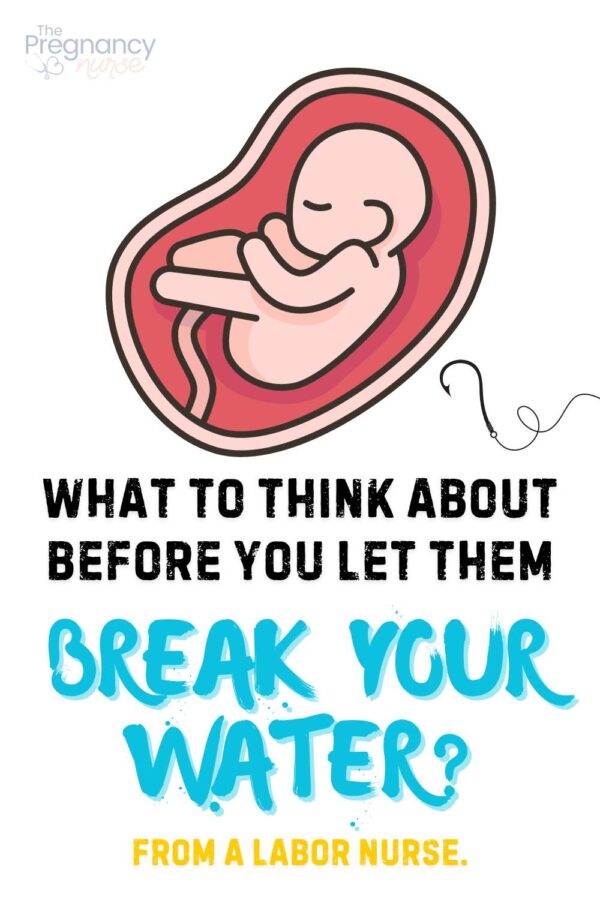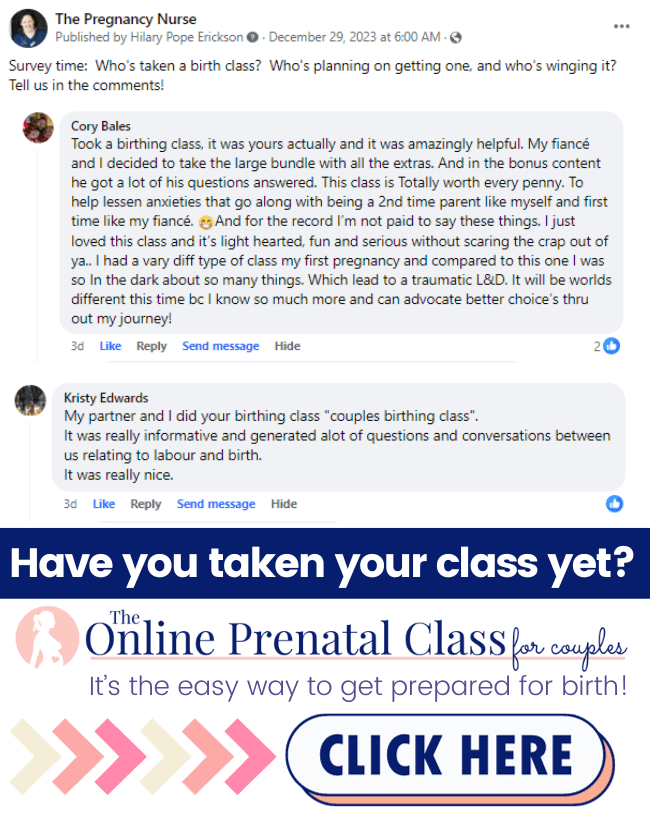📣 YOU are clearly getting prepared for pregnancy, birth & beyond — but do you wish your partner was more involved (looking for a teammate rather than just a cheerleader)? Couples love THIS! 💛🧡💚
If your provider wants to break your water, should you let her? Today I’m going to talk about some of the things you should think about if this situation arises.
Before we get going, this is a STICKY one for patients. Many don’t want it done, but then the provider comes in the room and recommends it and people jut end-up doing it. HENCE, it’s a great one to talk about in advance– to give you some real tools to manage this.
Want more tools like this? — Come join me in the Provider Communication bonus video in here. I actually go over this, and a few other scenarios, to speaking with your provider in a way that gets the information you want, and puts the ball in your court. SO helpful.

Vocabulary check:
AROM – Artificial Rupture of Membranes (your provider goes in with an instrument who’s purpose is to break water, normally looks like a crochet hook, or a condom with a little hook on the front)
SROM – Spontaneous rupture of membranes — when your water breaks on its own (tends to happen less than 10% of the time).
So, MOST people’s water is broken by a provider (and some people’s water breaks in the hospital)

First and foremost — you need to know this:
AROM Requires Informed Consent
Rupturing your membranes can have serious consequences, and it is always YOUR CHOICE to have it broken.
I should say that sometimes water breaks during an exam on accident. This especially happens if you’re having strong contractions and we check you during one. This article is mainly talking about your provider going in on PURPOSE to do so. However, if you don’t want your water broken I think it’s fair to mention at any exam.
Informed consent includes:
- Risks – most often infection, or possibly needing a c-section if baby isn’t tolerating labor with less fluids
- Benefits – providers normally say it will speed up labor (more on that, don’t worry)
- Alternatives – not doing it, or waiting — most often.
These all vary depending on you, your labor, your circumstances, etc.
Much of labor is like that — which is why I love a birth plan. Let me help you make yours here:
Before we get too far into this, let’s ask the big question:
Does breaking your water speed up labor?
What do the studies show?
This Chochrane review showed:
- There is no decrease to the first stage of labor with breaking water
- Studies didn’t compare how painful labor was with water broken or not (I tend to think it’s more painful from what I’ve seen — I talk about that more in my post on epidural before they break your water).
- There was a possible increase in cesarean sections if water was broken early (in the first stage — before 4-6 cm dilated when you’re in active labor)
- Their recommendation was that it NOT be used routinely in standard management of laboring patients.
- Keep in mind his study was for people with SPONTANEOUS labor vs an induction
What does my experience show?
I would agree. I’ve had doctors who can BARELY get the hook in trying to break water. I find that it decreases comfort and doesn’t speed things along.
I will say that sometimes with an induction you have to just “try things” when other things aren’t working and our limitations are strong as baby needs to come out (vs being in spontaneous labor).
I will say that sometimes when you get into active labor past the 6 cm mark, the bag of water pushing on the cervix isn’t enough pressure to open it and allow baby into the birth canal more, so breaking it can speed things along.
I should also say that if you’re past 6 cm and we break your water, some people’s dilation back-tracks as now it’s the HEAD pushing on the cervix not the water. Clearly, the head is going to have to push on it at some point — so it’s not surprising, but good to know.

Ok, now that we’ve studied that a bit – here’s a few things to ask yourself if your provider wants to break your water:
Are you in active labor?
In general active labor is considered after being 4-6 cm dilated. Since that is so vague, for me — it’s that your cervix is actively changing. We check you one hour and you’re a 4, and then an hour later you’re about a 5. Your uterus is engaged and making progress.
If you’re in active labor I honestly wouldn’t fight it — especially if you’re past 6 cm. Personally, I fought it and it just added to my time in labor. As soon as they broke my water and she descended VERY quickly into the birth canal.
Can babies be born without your water being broken? YES, they can! We call it “en cal” or a “mermaid birth” — it can happen. However I have seen many patient stall out if their water isn’t broken, so it needs to be managed in each case.
While we’re here, I can’t tell you any more firmly how important it is to understand the process and stages of labor as you’re making choices. Things change as you move along, so understanding things from start to finish gives you a leg-up. I recommend this. It’s really there to do just that!
Are you trying to go without the epidural?
I would hold off on having your water broken as long as possible if you don’t want an epidural.
This could possibly make labor longer, but it will allow you to cope with the contractions better, most likely.
Once your water is broken, most people say that the pain intensifies and is just harder.
Think of your uterus pushing on a baby inside an intact water balloon, vs how hard it could push on the baby without the water balloon around it. It does push harder (which is why they think you will progress more).
How Low is the Baby?
This isn’t ALL about dilation. We should also make sure that baby’s head is firmly applied to the cervix.
Sometimes when we check you early on, baby can bounce-up when we touch their head (we call this ballotable). That’s not what we want as this can allow the baby’s cord to slip out which is an emergency (and most often requires an emergency cesarean).

Are you happy with labor’s pace?
Are you happy with how labor is going? If so, you don’t need to speed it up.
Are you wishing it would go faster? Then, maybe you want it broken if you’re in active labor.
Both are fine choices — and always up to you! Don’t let a provider push you into breaking it if you’re happy with how things are going.
However, if things have stalled out I think it’s smart to consider.
In a similar way, sometimes providers try to add some Pitocin to your labor to “speed things up” — again, if you want things to go faster, give it a whirl — but if you’re happy with how things are going to can always refuse it, or ask for more information as to why.
AND, the extra good news, you can change your mind if things seem to stall. You can then request they break it later.
Providers often say “well, I won’t be back til’ after office hours” to get you to do it at the early morning visit, but most often they will be in at lunch, or a friend of their’s, or a resident — someone can break it even if they’re not there. Don’t let that make your choice.
Believe you me, if your labor nurse things your labor has stalled out she will get your provider to figure something out.
And lastly, a couple of things people don’t realize:
It’s gross.
In my experience, a lot of people get their water broken early on by pushy providers and then just HATE the gross feeling of that water continuing to come out until baby is born.
Many describe it as them peeing themselves every time they change position. We have pads to put under you, but some people are just GROSSED out by it (check out my other gross things in this post).
I just think that’s important to know, and catches a lot of people off-guard because we don’t talk about it. SO, I’m talking about it.
Finally, you should also know that once your water is broken you are committed to having this baby.
Which is fine if you’re in active labor (you’re already on that road). It’s also fine if baby HAS to come out (you have high blood pressure, or some other issue the requires baby being born). But if an induction doesn’t work your only option will be a cesarean. If your water wasn’t broken you might be able to go home instead (and try again later) — I think that’s important to know!
Let me just say that breaking your water is just ONE choice during labor. I have tried to expand-out this decision so you could understand it, but there’s going to be more than just this. Learning to make these choices with the advice of your team is one of the smartest things you can do.
I recommend The Online Prenatal Class for Couples to learn how to make those choices better. People are SO glad that they took it!
Sources:
Smyth RMD, Markham C, Dowswell T. Amniotomy for shortening spontaneous labour. Cochrane Database of Systematic Reviews 2013, Issue 6. Art. No.: CD006167. DOI: 10.1002/14651858.CD006167.pub4. Accessed 29 May 2024.
Be sure to check out my post on EVERYTHING you need to know about your water breaking for more on this important topic!








 10 Things to Do When You Find-Out You’re Pregnant
10 Things to Do When You Find-Out You’re Pregnant
